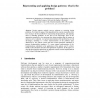Free Online Productivity Tools
i2Speak
i2Symbol
i2OCR
iTex2Img
iWeb2Print
iWeb2Shot
i2Type
iPdf2Split
iPdf2Merge
i2Bopomofo
i2Arabic
i2Style
i2Image
i2PDF
iLatex2Rtf
Sci2ools
UML
2005
Springer
2005
Springer
Representing and Applying Design Patterns: What Is the Problem?
Design patterns embody proven solutions to recurring design problems. Ever since the gang of four popularized the concept, researchers have been trying to develop methods for representing design patterns, and applying them to modeling problems. To the best of our knowledge, none of the approaches proposed so far represents the design problem that the pattern is meant to solve, explicitly. An explicit representation of the problem has several advantages, including 1) a better characterization of the problem space addressed by the pattern—better than the textual description embodied in pattern documentation templates, 2) a more natural representation of the transformations embodied in the application of the pattern, and 3) a better handle on the automatic detection and application of patterns. In this paper, we describe the principles underlying our approach, and the current implementation in the Eclipse Modeling Framework™.
Design Patterns | Design Patterns Embody | Design Problem | Natural Language Processing | UML 2005 |
| Added | 28 Jun 2010 |
| Updated | 28 Jun 2010 |
| Type | Conference |
| Year | 2005 |
| Where | UML |
| Authors | Hafedh Mili, Ghizlane El-Boussaidi |
Comments (0)

